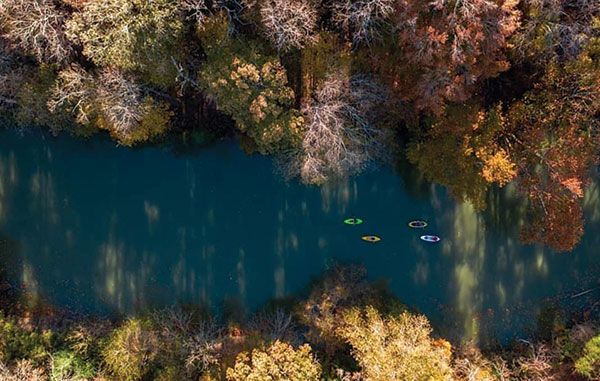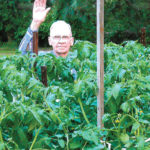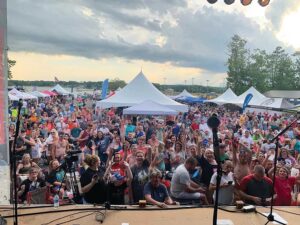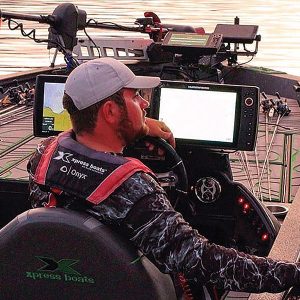

St. Clair lakes play prominent role in epic paddle race
Story by Scottie Vickery
Submitted Photos
Seven days, 8 hours, 1 minute and 55 seconds after launching his kayak at Weiss Lake in northeast Alabama, Bobby Johnson paddled his way to the finish line at Fort Morgan in Mobile Bay.
He’d spent a little more than a week traversing 650 miles of Alabama waterways, battling the heat, alligators, exhaustion and hunger to win the inaugural Great Alabama 650, a world-class paddle race held in September. He and his 17 competitors raced along the core section of the Alabama Scenic River Trail, the longest river trail in a single state.
“It was incredible,” said Johnson, who lives in Dunedin, Fla., and first started kayaking about four years ago. “The people of Alabama are awesome, and the scenery was amazing. Every day you saw something beautiful – sunrises, sunsets, the hills, the very dense woods. The wildlife was unbelievable. Everybody I talk to; I recommend that race all day long.”
That’s exactly what organizers of the Alabama 650 like to hear. They know the state has the most “experience-diverse” river trail in the country, and they want to share it with as many people as possible. “In Alabama, we’ve got more navigable waterways than any other state except Alaska,” said Jay Grantland, executive director of the Alabama Scenic River Trail. “There’s everything from whitewater to flat water, big lakes and small streams. There’s just about every type of water you’d want to paddle on throughout that river system.”
Trail Angels
The success of the race, which boasted a $22,500 prize split among winners in three divisions, relied heavily on volunteers known as “Trail Angels,” including Max Jolley, who lives at Powell’s Campground on Logan Martin Lake. Competitors were required to stop at nine portage locations along the Coosa and Alabama Rivers – Weiss, Neely Henry, Logan Martin, Lay, Mitchell and Jordan dams, and Robert F. Henry, Millers Ferry and Claiborne lock and dams – as well as two checkpoints.
“The volunteers were one of the most important factors of making this race successful all along the 650 miles,” Grantland said. “As the days roll on, the racers get further and further apart so we had to rely on the volunteers to man those different portages to make sure everyone was safe and performing fairly.”
While some racers had professional crews to help carry their boats and gear around the dam, others had one person or relied on volunteers. To keep it fair, the racers had mandatory rest breaks of 30 or 45 minutes, so race officials or volunteers had to track the time they arrived and left each portage.
“Apparently this long-distance paddling is a thing out in the world,” Jolley, who volunteered at Logan Martin Dam, said with a laugh. “It was exciting, and it was a fun learning experience for me. I got to talk to each of the kayakers and the crews and learn some of their strategies, and we helped get the kayaks out and made sure everyone had some food and water. I can’t wait to do it again next year.”
Jolley especially enjoyed the digital spectator experience. Thanks to GPS transponders, race officials and anyone who was interested could track the racers on the Alabama Scenic River Trail’s website and Facebook pages. “We knew where everyone was at every minute,” Grantland said.
Competitor Salli O’Donnell was in the lead for most of the race, and Jolley was keeping tabs on his computer to see when she was heading his way. “When I saw she was getting close, I went out and took a picture of her, and then I jumped in my truck and headed down to the dam,” he said. Because Logan Martin was one of the first portages, the racers were still fairly close together. Jolley said he stayed at the dam about seven hours and saw most of the kayakers come through during that time.
Jolley and others also posted about the race on social media, which helped stir up excitement among lake and river enthusiasts who offered encouragement from docks and boats. “Every one of the kayakers, almost to the person, were talking about how great it was seeing people on the lake cheering them on,” Jolley said. “They didn’t expect that.”
Johnson, 41, said it was a game-changer for him. “The people were awesome,” he said. “When you have people on the banks screaming your name and cheering you on, it’s an instant boost. It always seemed to happen just when you needed it most. If you’re just paddling for 650 miles, and you’re not talking to anyone or seeing anyone, you’re just paddling. This made me feel like a racer.”
Jolley said he was thrilled with the racers’ reaction to the hospitality on the lake. “That made me feel better than anything,” he said. “I wanted Logan Martin to be remembered for the people and the beauty of the lake.”
He was also impressed with the attention to detail the organizers put into the race. “A lot of planning and strategy went into it, I’ll tell you that,” Jolley said.
Behind the Scenes
Grantland said the idea for the race came about in early 2018 after he and some of the nonprofit’s board members had been to an outdoor adventure show in Ontario to promote Alabama’s recreational offerings and the river trail.

The Alabama Scenic River Trail got its start about 12 years ago when Fred Couch, an avid paddler from Anniston, spearheaded the efforts to divide the 650-mile stretch of water into four sections and provide guides for each one with information on parking, camping, launch sites and emergency phone numbers.
“It was great for families because it gave everyone peace of mind,” Grantland said, adding that the guides are available on the website. “They could take the kids camping without having to do all the homework and figuring it all out on their own. It started bringing in tourists.”
That core 650-mile section got so popular that officials from other areas wanted to add information about their waterways, too. “Here we are almost 12 years later, and we’ve gone from 650 to right at 5,600 miles” of navigable waterways, he said.
The impact has been a big one. “It’s definitely a quality of life benefit,” said Grantland, who started paddling when he was 10. “You can get the children outdoors and away from the TV.” There’s an economic benefit, as well. If you’re trying to attract businesses or corporations, they’re looking for areas with a good quality of life for their employees.”
Returning from the adventure show, the group brainstormed ideas for promoting the river trail out. “We wanted to put it out there to the world,” Grantland said. “That got the ball rolling, and then I started Googling. I have a master’s degree from Google in paddle racing.”
Serious planning began about this time last year, and Greg Wingo, who has a background in adventure racing, was hired as race director. “Between my experience in paddling and his experience in adventure racing, we were able to put together a pretty good race,” Grantland said. “It took a massive amount of coordination.”
Pushing limits
Racers could enter in three categories: male solo, female solo and two-person teams. Eighteen racers registered (some individually, some in teams), but only four finished the race: Johnson, O’Donnell and teammates Ryan Gillikin and Susan Jordan.
“This year, we really didn’t know what to expect, and we took anyone who wanted to register,” Grantland said. “Obviously, some didn’t have the ability, but it was fine because it brought a lot of attention to the race.”
Word is spreading about the event, one of a handful of long-distance paddle races, and Grantland says he expects they’ll have to put a cap on the number of competitors next year. In addition, racers will have to qualify by completing one of several pre-requisite races prior to registration, which opens in January.
Next year, organizers also hope to host a 65-mile race in conjunction with the Alabama 650. Paddlers who can finish it in 24 hours will qualify for the 2020 Alabama 650.
Johnson said he’ll be back and is doing his part to spread the word. “We’ve got some world-class paddlers who are going to race next year,” he said. “I personally thought it was the best thought out, well-planned race I’ve ever been in.”
It was one of the hottest, as well. Alabama recorded record-high heats for many of the race days, and Johnson felt the effects. “The first eight miles of that race to the first portage, I overheated and got heat exhaustion and couldn’t paddle,” he said. “At five or six miles in, my mouth was dry, and my arms were like lead. Everybody went past me, and it took me 500 miles to catch Salli.”
Along the way, he had plenty of time to enjoy the solitude, the views and the wildlife. “I felt like I was in a saltwater aquarium there were so many fish jumping in front of my boat,” he said. As he got closer to the Delta area, the fish gave way to alligators. “I saw them one after another after another after another,” he said.
Despite the mental and physical exhaustion, Johnson said he never thought about giving up. “I have an 8-year-old daughter, and I would never come back to her and say that I quit,” he said. “You’ll never know anything about yourself if you quit. If you don’t push through that wall of misery or pain, you’ll never know what you can actually achieve. Our human bodies are only stopped by our minds, that’s it.”
Link to map of course: alabamascenicrivertrail.com/uploadedFiles/File/Alabama_360_Map_Guide_Book_with_Portages_7-25-19.pdf


















